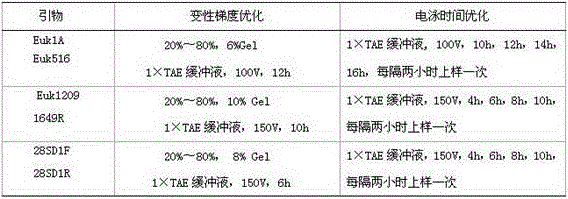Method for identifying marine nematodes by denatured gradient gel electrophoresis
A technique of denaturing gradient gel and marine nematodes, which is applied in the field of identification of marine nematodes by DGGE technology, and achieves the effect of good distinction and identification
- Summary
- Abstract
- Description
- Claims
- Application Information
AI Technical Summary
Problems solved by technology
Method used
Image
Examples
Embodiment Construction
[0034] The present invention will be further explained below in conjunction with embodiment.
[0035] References: Diez B., Pedros-Alio C., Marsh T. L., et a1. Application of denaturing gradient gel electrophoresis (DGGE) to study the diversity of marine picoeukaryotic assemblages and comparison of DGGE with other molecular techniques. Applied and Environmental Microbiology, 670 (7): 2942-2951.
[0036] EXAMPLES The method for identifying marine nematodes using deformable gradient gel electrophoresis comprises the following steps:
[0037] (9) Sampling and indoor sorting
[0038] (10) Morphological identification
[0039] (11) Extraction of total DNA
[0040] (12) Design and optimization of PCR primers
[0041] (13) Agarose electrophoresis detection
[0042] (14) Preparation of denaturing gradient gel
[0043] (15) Optimization of denaturing gradient gel electrophoresis conditions
[0044] (16) Using denaturing gradient gel electrophoresis to identify and analyze marine ...
PUM
 Login to View More
Login to View More Abstract
Description
Claims
Application Information
 Login to View More
Login to View More - R&D
- Intellectual Property
- Life Sciences
- Materials
- Tech Scout
- Unparalleled Data Quality
- Higher Quality Content
- 60% Fewer Hallucinations
Browse by: Latest US Patents, China's latest patents, Technical Efficacy Thesaurus, Application Domain, Technology Topic, Popular Technical Reports.
© 2025 PatSnap. All rights reserved.Legal|Privacy policy|Modern Slavery Act Transparency Statement|Sitemap|About US| Contact US: help@patsnap.com


